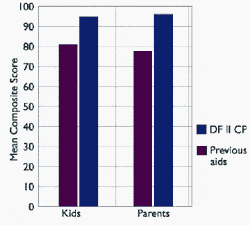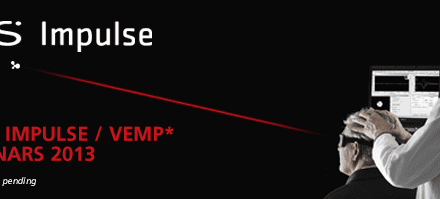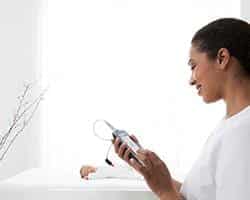The clinical performance of digital instruments has been well documented for adults and children with mild-to-moderate sensorineural hearing loss.e.g., 1-3 Following the introduction of DigiFocus II Compact Power BTE, a major multinational clinical trial was initiated by Oticon Inc. to evaluate whether school children with severe-to-profound sensorineural hearing loss would benefit from this new technology.
In many respects these patients are totally dependent on their hearing instruments, so any increase in performance is likely to be significant. Ironically, fitting this particular group with digital solutions is not yet universally accepted. This may be partly due to the absence of clinical documentation relative to children with severe hearing impairments and their use of advanced multi-channel, non-linear amplification.
The following study—which the authors believe is one of the most comprehensive clinical trials yet undertaken on severely hearing-impaired children—aims to provide valuable, objective information on the progress children can make with digital power instruments.
The Test Hearing Aid
People who have severe hearing losses have specific amplification needs that are quite different than those experienced by people who have mild-to-moderate losses.
A major difference between the regular and power versions of this study’s test instrument (ie, DigiFocus II Compact Power BTE) is its performance for higher input levels. The “power version” features a prescriptive rationale that is an extension of the ASA2 fitting approach—hence the name ASA2p. This rationale enables the use of a manual volume control that can alter the overall loudness of the instrument in certain extreme listening situations. The ASA2p algorithm automatically determines the required gain levels according to the intensity of current input levels, but the volume control wheel can provide a programmable offset from these prescribed characteristics. Whereas a conventional volume control sets absolute gain, the digital control wheel of the DigiFocus II Compact Power (DFII CP) aid has been described as a “manual override” to the automatic gain control system.
While the instrument continues to provide compression over a wide dynamic range, the output limiting strategy has been changed to provide compression. This is designed to provide more headroom, using more of the upper levels of the typically narrow dynamic range. To complement this change, ASA2p prescribes relatively more gain for moderate- to high-level inputs, predominately by the use of lower compression ratios in both channels.
These gain and compression settings have been based on a new loudness model, specifically developed for severely hearing-impaired people. The algorithm also prescribes the MPO independently of the gain specification—a feature that can also be used during fine tuning. Additionally, greater fine-tuning possibilities have been enabled by the provision of the kneepoint adjustment trimmer in the software. The trimmer can be manipulated for those experienced linear aid users who may feel overwhelmed by the greater audibility of the soft sounds provided by the new aid.
Study Method
The study’s purpose was to compare the test instrument to the typical technologies that are currently used to fit children. To ensure the study’s relevance to a wide variety of clinical settings and previous instrument types, 48 children were drawn from nine independent clinics in five countries. All clinics actively dispensed and managed pediatric hearing instrument fittings. Reimbursement for the instruments was in accordance with each clinic’s usual practice.
The study consisted of a series of test sessions. Initially, a complete audiological evaluation was conducted to confirm degree and type of hearing loss. All current hearing instrument fittings were evaluated for appropriate fit and function according to the strict test criteria (see below). Once this was completed, aided thresholds were obtained and speech understanding in quiet and noise was assessed. In addition, the child’s parents completed standard questionnaires about their current hearing instruments.4,5 The children completed their own questionnaires with the assistance of their parents and/or the audiologist.
Following the testing of the child’s current amplification system, they were fitted with test instrument using the ASA2p fitting algorithm. A follow-up appointment was made if any fine tuning was necessary. After wearing the instruments for at least 2 weeks, speech intelligibility tests were completed in both quiet and noise. The last visit was scheduled in the 6th week, at which time additional speech tests were performed. A questionnaire evaluating the fitting and final preferences was also filled out by the child and the parents.

|
| Figure 1. Mean hearing levels of children in the study (n=48). |
Previous Fittings and Test Criteria
All subjects’ hearing thresholds were greater than 65 dB HL with air/bone gaps of 15 dB or less (Fig. 1). In general, hearing loss ranged from 65-95 dB HL. The age of the children was 5-14 years old, with an average of 8 years and 9 months. Their current amplification consisted of a variety of devices, including analog linear and analog programmable instruments with either remote-controlled, multiple memory capability or multi-channel analog approaches. As high-powered digital instruments are relatively new to the market, only one child had previously worn a digital instrument (Table 1).

|
| Table 1. Distribution of previous device types according to country. |
To be consistent with the design of a “well-fitted upgrade” type of study, the child’s previous instruments had to reflect the current acceptable local clinical practice. Minimum standards for appropriate previous fittings included:
- Device fitted within the past 4 years;
- Device functional on a daily basis;
- Device used at least 20 hrs/week;
- Device free from acoustical feedback during normal use;
- Child reports that loud sounds are tolerable;
- Child reports that devices are physically comfortable to wear;
- Device provides estimated aided gain of at least 1/3 hearing loss at 500, 1000 and 2000 Hz (insertion gain is not feasible because of acoustic feedback).
Objective Test Results
Aided threshold assessment results found that, on average, a substantial increase of audibility of the softer sounds was possible with the test instrument. This was even more pronounced for those children whose previous instrument had a linear response. While aided thresholds do not necessarily imply intelligibility, it is well established that making previously inaudible sounds audible can often increase speech discrimination.

|
| Figure 2. Mean aided thresholds of previous aids and test aid, plotted on the average speech spectrum. |
Audibility: The mean results of aided threshold assessment of both the previous aids and the test instruments are illustrated in Figure 2, where they are superimposed on an audiogram displaying the long-term average speech spectrum. The data shows an increase in audibility of softer mid-frequency sounds, corresponding to the consonant region of the speech spectrum. This was caused by the interaction between hearing thresholds in the 65-95 dB region and soft gain compensation of around 70%, placing the aided threshold increases of around 8-10 dB in the center of the consonant region of the speech spectrum. This finding indicates that the severely hearing-impaired individual can particularly benefit from multi-band non-linear amplification.
Speech intelligibility measures: Pre-recorded local versions of pediatric speech tests were used in all the study’s clinics, with most using a picture-pointing response format. Sweden and South Africa were the first countries to begin the study, and used Phonetically Balanced Kindergarten tests (PBK) to determine speech intelligibility. These were performed with the fixed signal-to-noise ratios (SNRs) that typically are experienced by severely hearing-impaired children. The experiment was performed with the child’s previous instruments and later with the test hearing instruments two weeks after fitting. As indicated in Fig. 3, the average performance in noise dramatically improved when using the test instrument.
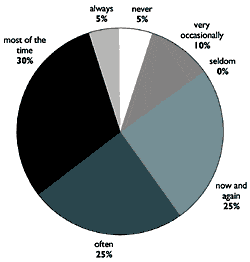
Figure 3. Speech Intelligibility Test: mean in quiet and noise for previous instruments and test instrument (Swedish and South African clinics). |
In the U.S. and Italy, monosyllabic word lists were presented at 70 dB SPL in quiet in the sound field at 0° azimuth. Initially, the child’s own aids were used at the usual volume control setting. In noise, speech was kept constant at 70 dB SPL, with the noise signal starting at +5 dB SNR using multi-talker babble. Noise was then systematically adjusted to determine the SNR that obtained a percentage correct score within the 40-60% range. These SNRs were determined individually to maximize reliability of the test materials.
Once the SNRs with the conversational speech levels were determined, a measure of soft or distant speech was determined by reducing the levels of speech and noise by 5 dB, and then another two word lists were completed. The SNRs were recorded on the child’s case notes, then the tests were repeated using exactly the same SNRs for the test instrument.
As shown in Figure 4 (page 56), the American children experienced a small average improvement in quiet after using the test instrument for two weeks, and this trend continued upon re-testing another 6 weeks later. In noise with speech at a conversational level, a substantial mean increase in intelligibility was evident only two weeks after fitting, but no further improvements were evident upon re-testing 6 weeks later.
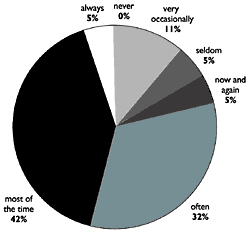
|
| Figure 4. Improvement in word recognition scores in quiet and noise (US clinics). |
When speech in noise was then presented at a softer level, a moderate increase in intelligibility ensued at the two-week point, and a further moderate increase occurred by 6 weeks later. Thus, over an 8 week period from fitting, a substantial increase of speech intelligibility had occurred, suggesting that the auditory pathways and centers required an extended period of time to adapt to the new aided signal before full processing efficiency was achieved.
Because the 21 children in the US clinic sample were using the same type of speech test, the number of participants was sufficient to make a parametric statistical analysis of these results. The analysis shows that the increases in speech intelligibility generated by the test instrument were statistically significant (p<0.01) for all speech signal conditions and measurement periods.
In addition to being significant from a statistical viewpoint, the results were significant from a clinical viewpoint, corresponding to the verbal reports of the children, their parents and teachers. Scientifically, they are also quite significant, as performance increases of this magnitude have rarely been seen in a well-controlled study where the previous instruments were so well fitted, thus providing strong empirical evidence of the potential of this technology to assist children who have severe hearing loss.
A new, computer-based speech testing system was specially produced in Italy for the study, featuring audio-visual training sequences and touch-screen response options. The production of this new system was required because pre-existing speech tests with closed-set response options were not sufficiently controlled for research purposes. The speech stimulus that was used in the new program was initially based on the NU-CHIPS test, but had been methodically re-constructed in Italian.6 The protocol for determining the reliable SNRs was consistent with the US clinics’ protocol. The data in Fig. 5 indicates that the performance of the test instrument in noise (>8 weeks post-fitting) was dramatically better than the previous instruments.
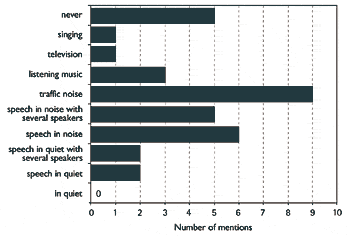
|
| Figure 5. Speech Intelligibility Test: means in quiet and noise (Italian clinic). |
The Polish clinic used the AudioVisual Features Test,7 which they had specially produced in an auditory-alone Polish version with closed-set responses to enable them to participate in the study. Figure 6 shows the mean results performed in quiet. This data indicates that the speech intelligibility performance of the test instrument in quiet was better than previous aids, and that it continued to improve when re-tested 6 weeks later.
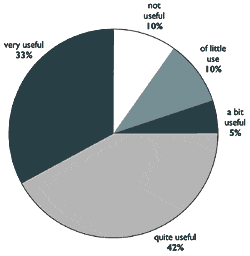
|
| Figure 6. Mean for previously worn instruments versus test instruments on the Audiovisual Features Test in quiet, 2 and 8 weeks post-fitting (Polish clinic). |
The Polish AudioVisual Features Test was also performed in noise, and the results expressed in terms of SNRs required to obtain the 50%-correct level. Figure 7 compares the previous aids to test instrument 2 weeks after fitting. Previously, the average result was a positive SNR (speech louder than noise), but the test instrument yielded a negative SNR (ie noise louder than speech) with a corresponding 1.4 dB improvement, indicating that the children could cope with considerably more noise.
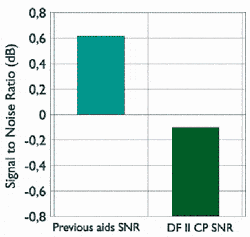
Figure 7. Mean SNRs for previous versus test instruments for Audiovisual Features Test in noise (Polish clinic). |
Overall, speech testing across all countries indicated a similar pattern, whereby children’s speech intelligibility displayed small increases in quiet, and substantial improvements in the presence of noise. The improvements were most evident in situations where the children normally have the most difficulty (ie, softer speech in the presence of noise).
There was also significant evidence that the children adapted well to the non-linear response of the test instrument; follow-up speech tests conducted six weeks later showed further increases in speech intelligibility. These further improvements are consistent with the effects of neural plasticity, and serve as a reminder to clinicians that the full benefits of advanced digital signal processing may not always be immediately apparent.
| Questionnaire Assessment
Following the speech testing procedures, questionnaires about the previous instruments were completed. The questionnaires were answered by both the children and parents, and sometimes also by the child’s teacher, if appropriate. At the 6-week follow-up visit, another questionnaire was completed and submitted with final preferences (i.e., previously worn instrument or test instrument) by all parties.
All questions were then compared relative to the previous instruments versus the test instruments. Fig. 8 provides the overall composite scores. The eight listening situations encompassed: a quiet room, noisy room, distance in a large room, instructions when playing outdoor games, in a car, bus or taxi, listening to TV, listening to music, and listening for vehicles approaching. Interestingly, parents were more critical of the previous instrument’s performance, while both parents and children rated the test instrument substantially higher. As well as corresponding with the comments heard in the clinic, the differences between the previous and test hearing aid questionnaire ratings were also statistically significant (Children: t(33) =-4.809, p<0.01; Parents: t(47)= -7.53, p< 0.01). Figs. 9 and 10 display the high preferences of all children and parents (respectively) for the test instrument. According to a follow-up conversation with the participating clinic, the two American children who preferred their previous aids are actually now wearing the DigiFocus II Compact Power instruments. A post-hoc analysis of the questionnaires showed that both parents and children noted improvements related to the automatic nature and the cosmetics of the test instrument. Additionally, several parents noted that their children’s expressive speech had improved after receiving the test aids. |
Conclusion
The results of this clinical study reveal the benefit of fitting severely hearing-impaired children with advanced digital technology, particularly as evidenced by objective improvements in word recognition scores both in quiet and noise. In addition, composite scores for the questionnaires showed significant subjective improvement in eight listening environments. Ninety-six percent of all children and 93% of all parents chose to keep using the new digital hearing instruments rather than their previous instruments.
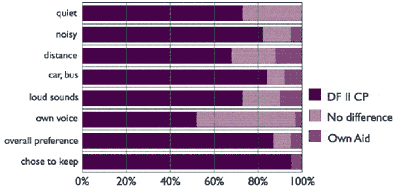
|
| Figure 9. Children’s hearing aid preferences for different listening situations. |
For some well-fitted children, the change to digital sound processing was different enough for them to initially choose to wear their previous instruments. However, in the long run, acclimatization to the new instruments and benefits of digital technology overrode these subjects’ perceived need to use their prior aids. On average, though, most children immediately preferred the test instrument, and the objective speech testing results also showed an immediate improvement in speech intelligibility, with this trend continuing to improve over further acclimatization time. On an individual level, this corresponded with verbal reports of many children having dramatic changes in their hearing performance, such as appreciating music for the first time, or now being able to use the telephone.

|
| Figure 10. Parent’s hearing aid preferences for different listening situations. |
The authors are presently preparing a 6-month follow-up evaluation on the American, Polish, and Italian children.
| This article was submitted to HR by Paul B. Davis, PhD, research audiologist at Oticon A/S, in Copenhagen, Denmark, and Randi Pogash, MA, manager of clinical product evaluation at Oticon Inc, Somerset, NJ. Correspondence can be addressed to HR or Randi Pogash, Oticon Inc, 29 Schoolhouse Road, Somerset, NJ 08873; [email protected]. |
References
1. Arlinger S, Billermark E, Oberg M, Lunner T, Hellgren J. Clinical trial of the DigiFocus hearing aid. Scand Audiol. 1998; 27:51-61.
2. Schum D, Elberling C. A new digital hearing instrument. Hearing Review. 1996; 38-39.
3. Schum D. Multinational clinical verification of effectiveness of DigiFocus for children with sensorineural hearing loss. News from Oticon. Aug 1998.
4. Grimshaw S. The extraction of listening situations which are relevant to young children, and the perception of normal-hearing subjects of the degree of difficulty experienced by the hearing impaired in different types of listening situations. Glasgow, England: MRC Institute of Hearing Research, unpublished report, 1996.
5. Bamford J, McCraken W, Peers I, Grayson P. Trial of a two-channel hearing aid (low-frequency compression high-frequency linear amplification) with school aged children. Ear & Hear. 1999; 20:290-298.
6. Arslan E, Genovese E, Orzan M, Turrini. Valutazione delle percezione verbale nel bambino ipoacusico. Ed Ecumenica Bari 1997;1-79, 1997.
7. Tyler RS, Champe G. An audiovisual feature test for young deaf children in English, French, Spanish and German. Adv Otorhinolaryngol. 1993; 48: 203-206.


